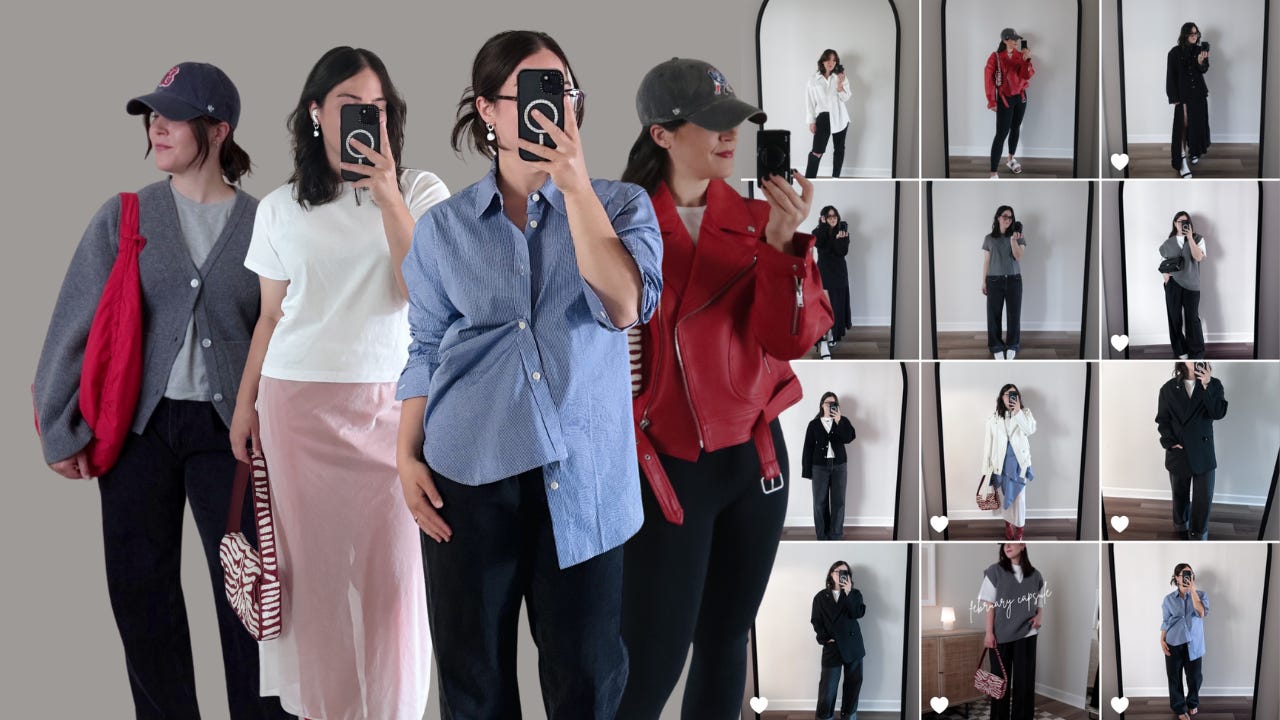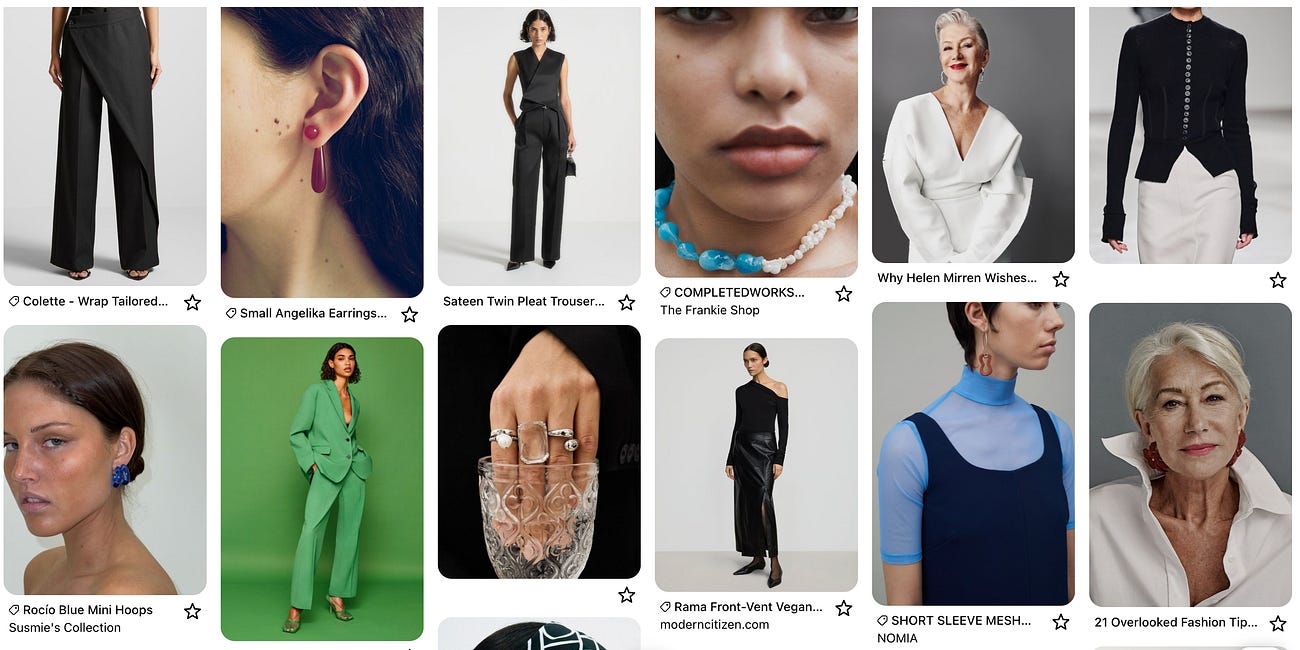So you’ve defined your Core Style using three adjectives and built a visual mood board to bring those words to life. Now, we need to ground all that inspiration in your real, everyday life.
Because here’s the truth: personal style can’t just exist in your head. True personal style is lived and experienced.
That’s why this week’s challenge is simple but powerful. Document your daily outfits.
Documenting your daily outfits is one of the best things you can do to fast-track your personal style development, so let’s start building your Outfit Journal.
core style
wardrobe editing
fit + measurements
silhouette + proportion
color story
texture
multidimensional style
conflict + balance
full outfits
Why Outfit Journaling Works
Outfit journaling is the missing link between inspiration and execution.
It’s one thing to say your style is relaxed, classic, sporty, but do your outfits reflect that?
By documenting what you actually wear, you start to notice the patterns, habits, and gaps that don’t always show up during a closet clean-out or in your mood board.
You might realize you’re wearing the same three silhouettes on repeat. You might spot a color that doesn’t work as well as you thought it did. Or you might discover that what felt basic was actually effortlessly cool.
Your Outfit Journal helps you:
Spot your most-used items and outfit formulas
Build awareness of your styling habits (good and bad)
Identify go-to pairings, colors, or proportions
Start seeing what feels off (and why)
Refine your core style words with real-life experience
This is how you stop overthinking your closet and start trusting your style instincts.
🗝️ Behind the Paywall [UNLOCKED]
This entry is fully unlocked so you can see what’s normally behind the paywall. If you like what you see, come join us. ✨
A step-by-step guide to creating your Outfit Journal (with or without selfies)
How to use Indyx to track and analyze your outfits with minimal effort
Journal prompts to reflect on your outfits and uncover your true style patterns
A bonus challenge to take your style growth to the next level
Private thread access to share your outfit wins and styling a-ha moments
You'll always receive the core lesson content as a free subscriber. Want all the exercises, bonus tools, and community access? Become a paid subscriber to get the full experience.
Exercise 3-3: Your Outfit Journal
Step 1: Document Your Daily Outfits
Start by taking a mirror selfie of your complete outfit every day for the next week. Don’t overthink it, just snap the photo, even if it’s not your favorite look. The goal is to capture what you actually wear.
Store your photos in a designated folder on your phone or use an app like Indyx to keep everything organized.
This is the #1 exercise I encourage all of my clients to do when they are struggling to develop their personal style, and it works every time. Seeing your own proportions and styling in the context of a full week of outfits gives you far more clarity on your style than a mood board ever could.
Short on time? Use Indyx to log your outfit by item instead. Photos are best, but this is still a great way to spot patterns in color, texture, and outfit formulas.
Step 2: Reflect at Week’s End
Once you’ve documented a full week of outfits, it’s time to step back and review.
Set aside a quiet moment, grab a cup of something warm, and approach this exercise with an open mind. The goal isn’t to critique your body or beat yourself up over less-than-perfect outfits. It’s to observe what’s working, what’s not, and discover the small adjustments that will bring you closer to your true style.
First, analyze the outfits you don’t like.
What could you change about these outfits to make them feel more you?
Is there a certain style element or feeling that these outfits lack?
What style words could describe these looks?
Next, analyze the outfits you enjoyed most.
What are your favorite elements of these outfits, and why?
How do these outfits make you feel? Try to use specific adjectives like “sharp” or “quirky” rather than more generic ones such as “comfortable” or “confident.”
What style words could describe these looks?
Look for patterns or recurring themes that can give you insights into your style preferences and areas for improvement. Specifically consider any items that may feel missing or details that feel a bit off.
Step 3: Keep Going!
To maximize your personal style development, keep logging your daily outfits and reflecting on them at the end of each week.
If you like a challenge, try recreating a few outfits you didn’t love, but tweak one element. Swap the shoes, add an accessory, or restyle the proportions.
This is a great way to stretch your creativity and gain deeper clarity on what works for you. Plus you might discover a few unexpected favorites.
💬 Discussion Prompt
Have you ever tracked your outfits before? How is it going so far?
What patterns are you starting to notice in your daily looks?
What’s one outfit that felt great and why?
Want to go deeper? Download the free Wardrobe Analysis Workbook for more exercises and insights to continue refining your personal style.
Until next time,
Alyssa
Yes, You Really Do Need a Mood Board
In Entry #09, you started to define your Core Style using three words that capture the essence of how you want to feel, how you want to look, and how you want to be.







I really need to do this. Need to just get over myself and take the damn photos!
I've had Indyx since Jan, but I've struggled with keeping up with the outfit pics. I work from home and dress in grubby clothes most often than not, so i'm not going to take photos of that. But I'm hoping to work on my wardrobe so that my at home/lounge clothes still fit within my wardrobe. I'm gonna take on the challenge of actually dressing for a while so I can get a better understanding of the patterns in my styling